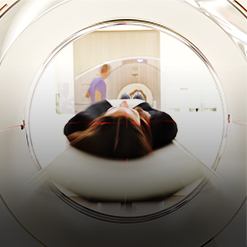Imaging Biometrics, creating the standard
In The News
IB Phase I Clinical Trial
Magnetic Resonance Imaging (MRI) is the gold standard imaging technique used for diagnosing and grading brain tumors, as well as for imaging the brain to evaluate whether a selected therapy is working. While conventional MRI with contrast agent is able to show the location and extent of a brain tumor prior to surgery, it is less reliable for tumor grading and monitoring a tumor's response to therapy.
Advanced MRI techniques provide information about tumor physiology that is not available using conventional imaging. Perfusion MRI is able to depict areas of increased vascularity, which are often associated with more aggressive tumor growth. It can be used to identify areas in a tumor that are likely to be higher grade (i.e. more aggressive), for more effective biopsy targeting and treatment planning. In addition, perfusion MRI has proven useful during and after therapy for distinguishing between areas of tumor regrowth, and areas of normal tissue response to chemoradiation. Diffusion MRI provides valuable insights into how densely cells are packed together, which can also help distinguish invasive areas of tumor from other areas of concern on conventional MRI.
Imaging Biometrics solutions help care teams analyze advanced MR brain images with the most proven and reliable tools in the industry. At every point in the care pathway, our solutions are there with the insights you need to provide the best patient care possible.
Software & Services
IB CLINIC® NEURO-ONCOLOGY APPLICATION SUITE
A complete suite of physiological imaging analysis tools for diagnosis, pre-surgical planning, treatment response monitoring and follow-up. Includes our flagship application, IB NEURO™ Perfusion MRI and CT analysis using dynamic susceptibility contrast images, and IB DELTA SUITE™ MR image registration and subtraction for improved comparison of post-contrast to pre-contrast images. IB DCE™ and IB DIFFUSION™ complete the analysis for advanced MRI.
IB CLINIC® ONCOLOGY APPLICATIONS
IB DCE™ Perfusion MRI dynamic contrast enhancement analysis.
IB DIFFUSION™ Diffusion MRI analysis.
IB PARTNER SOLUTIONS
STONECHECKER™ Kidney stone CT image analysis.
CUSTOM SERVICES
Software application development and commercialization with academic and industry partners.
Research Study Using IB Software Wins Top Award from AJNR
The American Journal of Neuroradiology has announced that its annual Lucien Levy Best Research Article Award for 2019 is presented to: Performance of Standardized Relative CBV for Quantifying Regional Histologic Tumor Burden in Recurrent High-Grade Glioma: Comparison against Normalized Relative CBV Using Image-Localized Stereotactic Biopsies by J.M. Hoxworth et al.
The paper reports on a study led by Dr. Leland Hu, MD (The Mayo Clinic, AZ) using IB's Neuro-Oncology software. The study demonstrated the usefulness of IB’s vascular mapping analysis in the differentiation of recurrent high-grade brain tumor from treatment effect. In addition, the study showed that IB's Image Standardization method was able to reduce the number of time-consuming manual steps required without sacrificing reliability.





